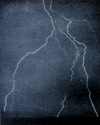 (source)
(source)
|
Alexander George McAdie
(4 Aug 1863 - 1 Nov 1943)
American meteorologist who followed Benjamin Franklin in employing kites in the exploration of high altitude air conditions. He was second director of the Blue Hill Meteorological Observatory.
|
THE THEORY AND PRACTISE OF FROST FIGHTING
BY ALEXANDER McADIE
BOTCH PROFESSOR OF METEOROLOGY, HARVARD UNIVERSITY
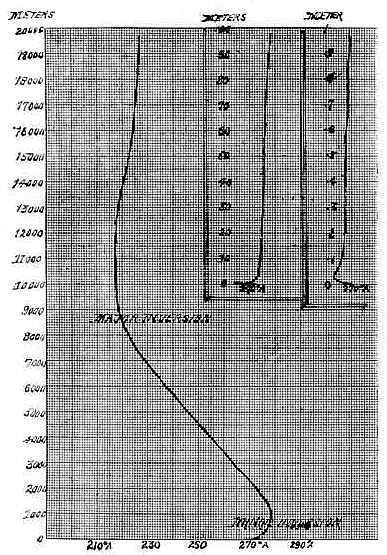
[p.292] Only in recent years have aerologists given much attention to the slow-moving currents of the lower strata of the atmosphere. These differ greatly from the whirls and cataracts of both low and high levels which we familiarly know as the winds. The upper and larger air streams play a part in the formation of frost, and we do not underestimate their function; but primarily it is a slow surface flow, almost a creeping of the air near the ground, which controls the temperature and is all-important in frost formation. So important is it that the first law of frost fighting may be expressed as follows:
Where air is in motion and where there is good circulation, frost is not so likely to occur as where the air is stagnant.
In other words frost in the ordinary meaning of the word is a problem in local air drainage is true that there are times when with thorough ventilation and mixing of the air strata the temperature will fall rapidly and damage from frost result; but such conditions are perhaps more fittingly described as cold waves or freezes, as distinguished from frosts. Thus, in California during the first week of January, 1913, when there was much air movement, the citrus fruit crop was damaged to the extent of $20,000,000. The condition is generally referred to as a frost, but it was quite different from the usual frost conditions in that section. It is, however, interesting to note that improved frost-fighting devices were used with much success and the total savings aggregated about $25,000,000. The orange growers also had the benefit of accurate forecasts and expert advice and were thus able to provide fuel and labor in advance. Passing over at present the larger disturbances, we shall consider only the frosts of still nights. And it should not be forgotten that the accumulated losses of these frosts may equal the losses of the individual freezes, for the latter occur at long intervals, while the quiet frosts of the early fall and the late spring are recurrent, destroying flowers, fruits and tender vegetation in many sections, year after year.
Air may flow in any direction, but attention has been centered more upon the flow in a horizontal than in a vertical direction. Thus none of the wind instruments used at Weather Bureau stations gives any record of the up and down movement of the air. In frosts of the usual type this vertical displacement is all-important. True, there may be brought into the district, by horizontal displacement, large masses of cold air and the temperature thus materially lowered; but the marked [p.293] inversion of temperature occurs only when these horizontal currents or winds are lulled. On windy nights, as is well known, there is less likelihood of frost than on quiet nights, because of the thorough mixing of the air vertically. There is then no tendency for stratification and the formation of levels of different temperature, followed by low surface temperature.
In general, the temperature falls as one rises in the air; but, at times of frost, it is found that the higher levels are warmer than the lower ones. The coldest stratum is found about ten centimeters (four inches) above the ground; while at a distance of ten meters temperatures are as much as five degrees higher than at the ground.
It may be well to refer for a moment to the variations in temperature known as inversions. In the accompanying diagram (Fig. 1) it will be seen that the temperature falls with elevation, and starting from the ground on a day when the temperature is near the freezing point, 273° A., [p.294] one finds at a height of seven thousand meters a fall of about forty degrees. It is not easy to represent on a single diagram the variation in detail and therefore we have divided the air column into three parts, the scales being as one to a hundred.
The right-hand diagram shows the gradual rise in temperature for a height of one meter and the peculiar inversion that occurs a few centimeters above the ground. Unfortunately it is in this layer where detailed temperature observations are most needed that our instruments are least satisfactory. Ordinary thermometers can not be relied on for such small differences and the exploration of this stratum by self-recording instruments is difficult. In the middle diagram is shown the temperature gradient at times of frost, from the ground to a height of one hundred meters. It will be seen that at a height of fifty meters the temperature may be ten degrees higher; and in general the rise continues with elevation.
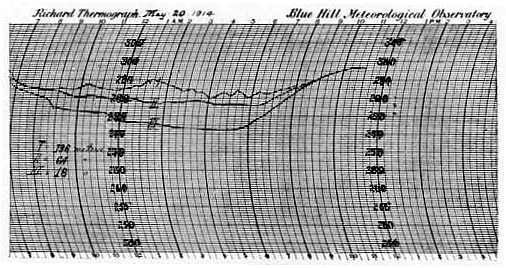
A good illustration of a valley inversion is given by the chart of May 20 (Fig. 2), in which continuous records for three levels, 18, 64 and 196 meters above sea level, are given. At such times fruit or flowers on hillsides escape damage from frost while in all the depressions and low level places the injury may be marked. These differences in temperature are not at all unusual and may be anticipated on clear, still nights during spring, fall and winter. Clouds or a moderate wind will prevent such an inversion. We shall refer again to this in speaking of the cranberry bogs of the Cape Cod district and the frost warnings issued from Blue Hill Observatory.
The great inversion in the atmosphere, however, is that which we have indicated as occurring at the height of nine thousand meters. Above this, the temperature ceases to fall and we enter what has been called the stratosphere or isothermal region. For convenience we will call this upper change the major inversion and the lower one near the [p.295] ground the minor inversion. In some ways we know more about the former than the latter. Strictly speaking, the minor inversion is the chief factor in determining local climate since it controls night and early morning temperatures and in large measure the early or late blooming of flowers and ripening of fruits.
Ordinarily cold air falls to the ground; but not always, for under certain conditions cold, heavy air may actually rise, displacing warm, lighter air. But such conditions can be explained and there is no contradiction of the fundamental law that if acted on only by gravity, cold air, being denser, will settle to the ground and warm air, being lighter, will rise. And there must be a certain relation between the height of the level from which the cold air falls and the level to which the warm air rises. In other words, we have to apply the laws of falling bodies since a given mass of air, although invisible, is matter and as subject to gravity as a cannon ball.
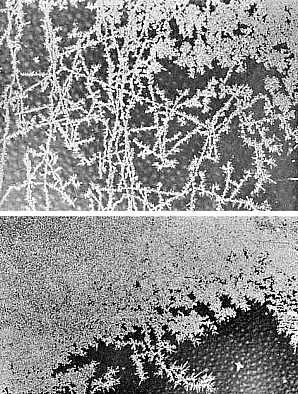
One of Galileo's most ingenious experiments consisted in swinging a pendulum and then by means of a nail driven in various positions intercepting the swing. He found that the bob always rose to the same level whatever circuit it was forced to take. But Galileo did not know what every schoolboy to-day knows, that air exerts pressure and is subject to physical processes like other matter, else he would certainly have given to the world a delicate air pendulum; and devised experiments on the movement of air that would have opened men's eyes to the fascinating flow and counter-flow of the air, even on a seemingly still night, one favorable for the formation of frost.
The problem of the moving air mass, however, is more complicated than it looks. For with the air is mixed a quantity of water vapor. In a strict sense they are independent variables, and the view set forth in most text-books that air has a certain capacity for water vapor is misleading. We seldom meet with pure, dry air. A cubic meter of such a gas mixture would weigh 1,247 grams, at a temperature of 283° A. (50° F.). If chilled ten degrees, that is, to the freezing point of water, it would weigh 46 grams more. So that by cooling, air becomes denser and heavier. A cubic meter of a mixture of air and water vapor at saturation, at the first temperature above mentioned weighs only 1,242 grams, or five grams less, and if this were cooled ten degrees the mixture would weigh three grams less than the same volume of pure dry air. We see that in each case the mixture of air and water vapor weighs less [p.296] than the air by itself. One would think that by adding water vapor which, while light, still has weight, the total weight would be the sum of both. It really is so, notwithstanding the above figures, and the explanation of the puzzle is that there was an increase in pressure with expansion, so that the volume of the air and saturated vapor was greater than one cubic meter. Since then a cubic meter of air and saturated vapor weighs less than a cubic meter of dry air at freezing temperature, speaking generally, we may expect moist air to rise and dry air to fall. Consequently, if in addition to falling temperature there is also a drying of the air, we shall have an accelerated settling or falling of cold dry air to the ground, which of course favors the formation of frost. The water vapor plays also another rôle besides that of varying the weight per unit volume. The heat received by the ground consists of waves of a certain wavelength; but the heat re-radiated by the ground consists of waves of longer wave-length, and these so-called long waves (12 thousandths of a [p.297] millimeter) are readily absorbed by water vapor. Thus water vapor acts like a blanket and holds the heat, preventing loss of heat by radiation to space. Further on we shall speak of the high specific heat of both water and water vapor as compared with air and show the bearing of this in frost fighting; but at present we may from what precedes formulate the second law of frost fighting as follows: “Frost is more likely to occur where the air is dry than where it is moist.” It is also true that a dusty atmosphere is less favorable for frost than a dust-free atmosphere. Thus we may generalize and say that whatever favors clear, still, dry air favors frost. The theory of successful frost fighting then is to interfere with or prevent these processes which as we have seen facilitate cooling close to the ground. In what way can this best be done?
The most natural way would be by conserving the earth's heat, which could be accomplished by covering plants with cloth, straw, newspaper, or perhaps better still, modern weather-proof sheeting, or in still another way by a cover of moistened dense smoke, generally called a smudge. A second method would be by means of direct application of heat; and this is accomplished in orange groves by means of improved orchard heaters. Large fires waste heat and are neither economical nor effective. A third method would be based upon a mixing of the air strata, thus getting the benefit of the warmer higher levels. Fourth, advantage might be taken of some agency such as water or water vapor, having a high specific heat. Finally, if the crop is of a certain character such as the cranberry, it will be found advisable to use sand, to drain and clean, here again making use of the specific heat of some intermediary. And, furthermore, any one of these methods may be combined with some other method.
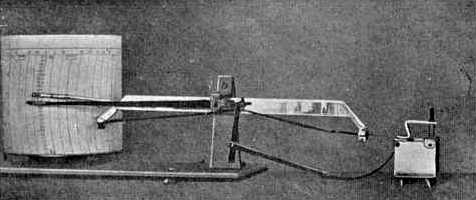
Regarding the first method, that of covers, it may be said that the practice goes back to the early husbandmen; but only in the last few years has the true function of the cover been properly interpreted and we are still far from obtaining maximum efficiency. Nor is there yet a suitable, scientific cover available. Any medium that interferes with [p.298] loss of heat through free radiation before and after sunset is a cover. The best type of cover is a cloud; and clouds, whether high or low, are good frost protectors. On cloudy nights there is little likelihood of frost; and when we can bring about the formation of a layer of condensed water vapor we can practically eliminate frost. We have mentioned above the fact that the earth radiates the heat it has received not in the same but in longer wave-lengths perhaps three times as long. These are easily trapped and held by the vapor of water. Furthermore, the rate of radiation is a function of the absolute temperature and so the rapidity of loss depends somewhat upon the heat received. Therefore the cover should be used as early in the afternoon as possible, that is just before sunset. Aside from the water cover or vapor cover there are cheap cloth screens, fiber screens and in some places lath screens.
The second method, that of direct heating, has met with much success in the orange groves of California and elsewhere. Modern heating and covering methods date from experiments begun in 1895. A number of basic patents granted to the writer in this connection have been dedicated to the public. At the present time there are on the market some twenty forms of heaters, which have been described with more or less detail in farm journals and official publications. It is not necessary to refer to them further here. The fuel originally used was wood, straw and coal, but these are now supplanted by crude oil or distillate. It has also been seriously proposed to use electric heaters; also to use gas in the groves. [p.299] With modern orchard heaters properly installed and handled, there is no difficulty in raising the temperature of even comparatively large tracts five degrees and maintaining a temperature above freezing, thus preventing refrigeration of plant tissue.
The third method, that of utilizing the heat of higher levels by mixing, has not yet been commercially developed; but the methods of applying water, either in the spraying of trees or the running of ditches or the flooding of bogs, together with methods of sanding, cleaning; and draining, have all been proved helpful. Methods available and most effective in one section may not necessarily be effective in another section or with different crop requirements. Certain devices most effective in the groves of California may not answer in Florida or Louisiana because of entirely different weather conditions. In the Gulf coast states where water is available it may be advantageously used to hold back ripening and retard development until after the cold waves of middle and late February have passed, whereas in the west coast sections conditions are very different, water having a definite value and the critical periods coming in late December or early January.
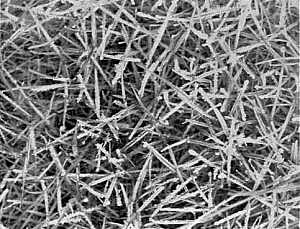
In what precedes stress has been laid chiefly upon the fall of temperature and the congelation of the water vapor. There is, however, another important matter connected with injury to plant tissue, and that is the rise in temperature after the frost. A too rapid defrosting may do considerable damage where no damage was originally done by the low temperature. It is in this connection that water may be used to great advantage. Water, water-vapor and ice have, compared with other substances, remarkably high specific heats. If the specific heat under constant pressure of water be taken as unity, that of ice is 0.49; of water-vapor 0.45 and of air 0.24. Or in a general way we may say that water has four times the capacity for heat that air has. Therefore it is apparent that water will serve excellently to prevent rapid change in temperature. This is important at sunrise and shortly after when some portion of the chilled plant tissue may be exposed to a warming sufficient to raise the temperature of the exposed portion ten degrees in an hour. The latent heat of fusion of ice is 79.6 calories and the latent heat of vaporization of water is nearly 600 calories (a gram calorie is the amount of heat that will raise the temperature of a gram of pure water one degree) or in exact terms from 273° A. to 274° A. Therefore in the process of changing from solid to liquid to vapor, as from ice to water to vapor, there is a large amount of heat required. The latent heat serves to prevent fall in temperature and also serves to retard a too rapid rise. This does not mean, as is generally assumed, that the air will be warmed, but it does mean a retardation of temperature change. And it is essential that the restoration of the tissues and juices to their normal state be accomplished gradually, neither too rapidly nor yet too slowly. [p.300] There is probably an optimum temperature for thawing or defrosting frozen fruits and flowers. Finally the temperature records as ordinarily obtained need careful interpretation. It may be that the freezing point of liquids under pressure in the plant cells or exposed to the air through the stomata is not the same as in the free air. It is unfortunate too that in most places data showing temperatures of soil, plant and air are of doubtful character. A word of warning may be given against the too ready acceptance of Weather Bureau records made in cities and on the roofs of buildings. Garden and field conditions vary greatly from these. It is further advisable to obtain a continuous record of the temperature of evaporation such as is shown by the records herewith. The two temperature curves made simultaneously and easily read at any moment enable the gardener or orchardist to forecast the probable minimum temperature of the ensuing ten or twelve hours. But not always, and some study is necessary. A slight increase in cloudiness or a slight shift in wind direction will prevent the fall in temperature which otherwise [p.301] seemed probable. With a persistent inversion of temperature there is sometimes an increasing absolute humidity.
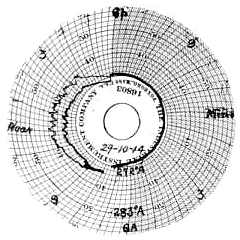
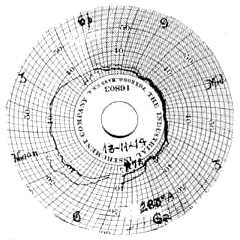
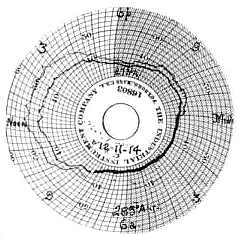
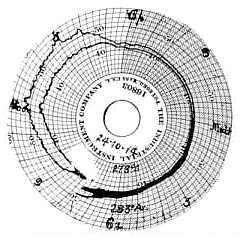
SUMMARY
The problem is many sided and we must consider the motion of the air vertically as well as horizontally. Air gains and loses heat chiefly by convection, and any gain or loss by conduction may be neglected. The plant gains heat by convection, radiation and perhaps by conduction of an internal rather than surface character. The ground gains and loses heat chiefly by radiation. But the whole process is complicated and may not even be uniform. Frosts generally are preceded by a loss of heat from the lower air strata, due to convection and a horizontal translation of the air. Then follows an equally rapid and great loss of heat by free radiation. There are minor changes such as the setting free of heat in condensation and the utilization in evaporation, but these latent heats are of less importance than the actual transference of the air and vapor and the removal of the latter as an absorber and retainer of heat.
Frosts are recurrent phenomena reasonably certain to occur within given dates, and, as pointed out above, the cumulative losses are considerable. Methods of protection to be serviceable must be available for more than one occasion, for there is no profit in saving a crop on one night and losing it on the succeeding night. But the effort is worth while. Consider that the horticulturist regularly risks the labor of many months on the temperatures of a few hours. An efficient frost fighting device is in a way the entering wedge for solving problems of climate control. One may not take a crop indoors, it is true, but there is no valid reason, in the light of what has been already accomplished, why at critical periods which may be anticipated, the needed volume of surface air may not be sufficiently warmed; and the losses which have heretofore been considered inevitable be prevented.
- 4 Aug - short biography, births, deaths and events on date of McAdie's birth.
- Articles written by Alexander McAdie
- Needless Alarm During Thunderstorms - article by Alexander McAdie from Century Magazine (1899).
- The Storage Battery of the Air - article by Alexander McAdie from Harpers New Monthly Magazine (1894).
- What is an Aurora - article by Alexander McAdie from The Century Magazine (1897).
- Muir of the Mountains - Alexander McAdie writing about John Muir in Sierra Club Bulletin (Jan 1916).
- Franklin's Kite Experiment With Modern Apparatus - article by Alexander McAdie from Popular Science (1897).
- Making the Weather, by Alexander G. McAdie. - book suggestion.




